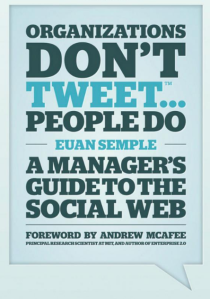Kimberly promised us eleven ways to turn free resources into powerful marketing and sales tools, and she certainly delivered, with additional excellent contributions from Warren Cass and Stefan Thomas.
Definition of Social Media – A conversation between you and your customers (or potential customers).
Research – Use Social Media to find out what are people saying about you and your competitors?
Surveys – Test – Feedback
Tools
The Marketing Master Class
Social Media for Business
Kimberly Davies
Story of Sarsaparilla
Flash, fluff and fakers
11 ways to turn free resources into powerful marketing and sales tools
Definition – A conversation
Powerful:
International
Instant
Connects people
No barriers
Viral
Easy (you don’t need to be tech savvy)
Is the future of marketing
Pre social media customer experience sharing
Good = 3 people, Bad experience = 9 people
Social media connects you to the world.
22% of online time in the US is on social networking
40 million tweets per day
20% of Twitter updates mention a business or brand
The Big Four – YouTube, Twitter, Facebook, Linked In
Twitter – 190 users – more tech savvy and higher incomes
Facebook – 600 million – casual not business – B2C
Linked In – 90 million – more service based businesses.
Facebook
half of UK population is now on Facebook
average user has 130 friends
90 items of content per month on average
Gets more visits than Google, people asking friends they trust for recommendations
25 fans enables you to get your own facebook domain address
Friends activities are recorded on stats page
Only .04% of adverts work on Facebook – compared to 8% on Google
Wall post conversions work better
Point your adverts to your Facebook page, not out of Facebook
Set your keyword campaign to run for two days, then go back an use same words at a lower price
Twitter
“the SMS of the Internet”
58% of tweeps have +$60k income
Mentions of you are visible
Needs a better tech understanding
Enables a direct link to people
Search topics and see what people are saying
You can brand your Twitter page
Tools – tweepi.com, twitpic
Hash tags – follow events and trending topics
Linked In
Six degrees of Kevin Bacon
job searching
gatekeeper
B2B
Great SEO – at least put in your basic profile details
Get recommendations for your business – much better than promoting yourself
YouTube
owned by Google
increases your SEO
for people who like to learn by watching than reading
can use Flip or iPhone – cheap and easy
Research
Use Social Media to find out what are people saying about you and your competitors?
Surveys
Test
Feedback
Tools
www.Uservoice.com
www.Openmind.com
www.Topsy.com
www.Clueapp.com
www.Surveymonkey.com
Build a database
lists, groups
get people to register their data
offer something for free in order to get people to sign up
don’t do it the wrong way – quality is more important than quanitity
www.getsatisfaction.com
Building your Brand
establish yourself as an expert – answer questions
have an opinion
loyalty
write articles and promote
www.ezinearticles.com
www.scribd.com
What can you write about?
What are you an expert on?
Trust is essential
– Your customers need to trust that you genuinely have their interest at heart.
Warren Cass
www.warrencass.com
www.business-scene.com
Why you should Network Online
Examples of Will it Blend and United Breaks Guitars on YouTube
Useful tools
www.Tweeteck.com
The power of blogging
host guest bloggers who have lots of traffic
comment on popular blogs
Customer Service
Monitor and respond to service issues
Give support
Answer questions
Respond to people’s comments, good and bad
People want to talk to people, not companies
Tools
CRM (Customer Relationship Management)
Via www.CoTweet.com
Events and promotions
invite
register
contests
direct people to your website, blog, etc
fundraising via sites like www.kapipal.com
increase awareness of who you are and what you do
ReTweet and Follow to enter
Networking
Keep up to date with what everyone is doing
Who moved
Build relationships
The world is listening
Reach a wider audience
Referrals
Introduce people to each other
Pay it forward
Recommendations – use in your marketing materials
Like Amazon Book reviews
Recruitment and Refresh
PR
Create a buzz
Viral Marketing
What you say can go further than you think
Sales
Promoting a sale. Launching a product
Build rapport
Today’s fans are tomorrow’s buyers
Create a demand, teasers, new products etc
Offer discounts
Create a Social Media Strategy
What are you going to use social media for?
Think long term
Plan
Write 5 things you’d tweet today
Do you need a Social Media manager?
Interns
Assistance
Virtual Assistants
Outsourced Professionals
Dual identities – business and personal
Tools
www.tweetdeck.com
www.hootsuite.com
www.cotweet.com
Words of caution
Facebook owns your photos – and changes the privacy rules regularly
15 minutes in the morning and 15 minutes at night
Friends don’t equal love
Beware of bots
Stefan Thomas – www.noredbraces.co.uk
Story of being an estate agent, made redundant
Pathological fear of public speaking
Top tips for real and social networking success
Don’t sell to your audience
Passion and confidence
Be aware of what you want to say – don’t make it up on the fly – you wouldn’t do that for a brochure or advert
When you get to a one to one – still don’t sell – treat it like a first date
People don’t go into online forums to be sold to – so don’t do it – build up a relationship first
Don’t use social media for selling
Social networking complements person to person networking, it complements it and keeps them warm.
 In my workshop Introducing Social Media for Small Business I talk about Twitter’s unique ability to engage with otherwise inaccessible public figures.
In my workshop Introducing Social Media for Small Business I talk about Twitter’s unique ability to engage with otherwise inaccessible public figures.










 First up was Fraser Docherty of Superjam. Fraser proved to be a very engaging and funny speaker. He told us how he started making jam, based on his grandmother’s recipes when he was fourteen, selling it door to door and at farmers markets before securing a deal with Waitrose. Social media and blogging provided him with a cheap and easy way to publicise his brand and communicate with his customers.
First up was Fraser Docherty of Superjam. Fraser proved to be a very engaging and funny speaker. He told us how he started making jam, based on his grandmother’s recipes when he was fourteen, selling it door to door and at farmers markets before securing a deal with Waitrose. Social media and blogging provided him with a cheap and easy way to publicise his brand and communicate with his customers. The next speaker was Ian Hogarth who set up the website Songkick.com, which allows members of the public to match their music interests to the site and then receive alerts when their favourite bands are playing. The site uses a “robot” which scours the Internet for concert and gig information.
The next speaker was Ian Hogarth who set up the website Songkick.com, which allows members of the public to match their music interests to the site and then receive alerts when their favourite bands are playing. The site uses a “robot” which scours the Internet for concert and gig information. Next up was the BBC’s technology correspondent Rory Cellan-Jones. Rory has witnessed first hand how social media, especially Twitter, has revolutionised news reporting. He used an example of the earthquake in Qinghai province in China last year which was reported on Twitter before it appeared on any other news media.
Next up was the BBC’s technology correspondent Rory Cellan-Jones. Rory has witnessed first hand how social media, especially Twitter, has revolutionised news reporting. He used an example of the earthquake in Qinghai province in China last year which was reported on Twitter before it appeared on any other news media. The last speaker was Justine Roberts from Mumsnet, the massively popular website for mums (and the occasional dad) with a phenomenal 1.2 million visitors each month.
The last speaker was Justine Roberts from Mumsnet, the massively popular website for mums (and the occasional dad) with a phenomenal 1.2 million visitors each month.



